If you know your edible weeds and these foraging tips, you could have a garden harvest even before you plant anything! It's great to get an immediate reward for a rehabbing a neglected garden area!
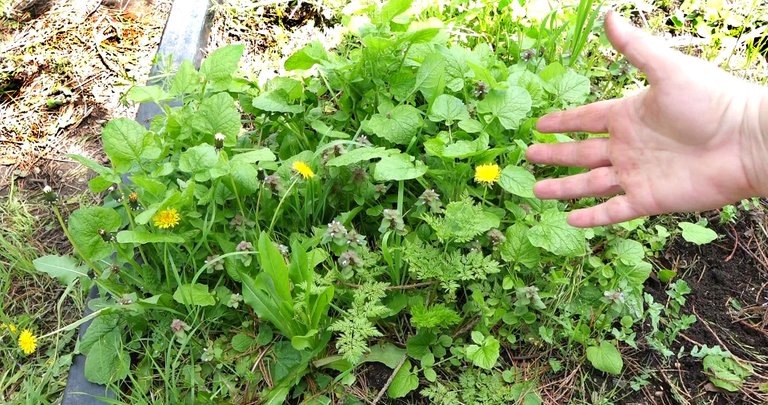

A Raised Bed Rehab Project
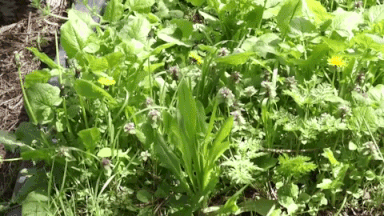

Tip 1: Pick Clean
Don't just pull a weed and toss it into a bowl or basket. Cut the roots off so the soil doesn't make it back to the kitchen. And double-check any clumps of plants to make sure there's nothing mixed in with that 1 kind of plant. After all, not every weed is edible!
.gif)
.gif)

Tip 2: Pick Organized
I made a Steemit post about 2 different strategies for efficiently picking garden weeds to eat. In a garden rehab, there's often a wide assortment of weeds. So I start off with a lot of bowls to hold the different kinds of weeds that I'm picking. I keep each kind of weed in its own pile. That way, it's a lot easier to double-check the plants back in the kitchen to remove any parts that are in poor condition -- or unwanted plants, like the really toxic one!
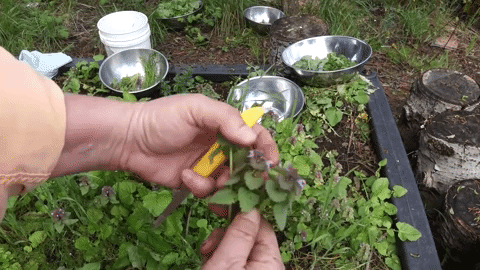.gif)

Tip 3: High-Grade
In picking garden weeds, we don't have to take everything. They're weeds, after all, so it's OK to high-grade, and just take the best plants back to the kitchen. Or the best plant parts.
.gif)
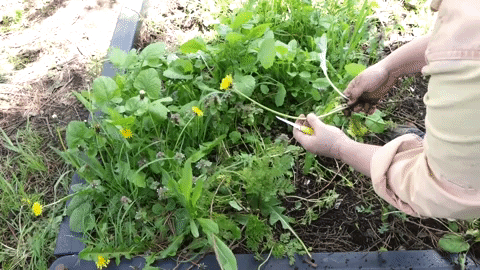.gif)

Tip 4: Learn to Identify a Lot of Weeds - Correctly!
There are so many wonderful weeds to eat. The more of them you get to know, the more food you can harvest! I am constantly amazed at how much food is all around us. And these plants are really tasty, too. It's not just for some imagined survival situation -- these plants are real food for regular people!
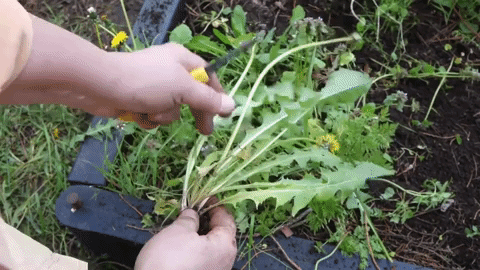.gif)
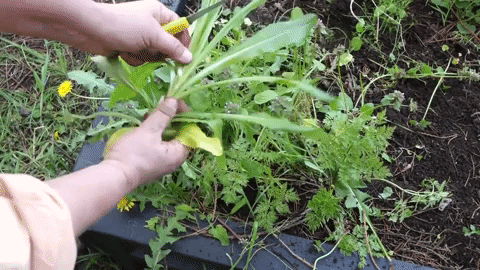.gif)
.gif)

Tip 5: Watch Out for Poison Hemlock
This is one plant that every gardener should know. Poison hemlock causes a lot of trouble -- for gardeners more than foragers! I keep track of poison hemlock reports in the medical literature and newspaper articles. Poison hemlock gets mistaken for garden carrots, parsley, fennel, and even kale. By inattentive gardeners, but especially when non-gardeners are helping with a harvest. Those reports are tough to read!
.gif)
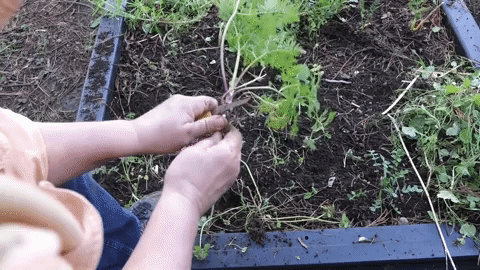.gif)

Enjoy Your Garden Weed Rewards!
It takes time for newly planted gardens to produce their crops. It's really satisfying to get an immediate reward -- even before planting anything! After clearing out my raised bed, it's all ready to plant now. And I've got a big batch of delicious wild greens to eat, too! Enough for days!
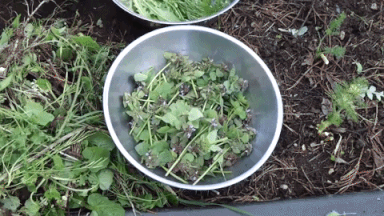.gif)
.gif)
.gif)

What Do You Think?
- Do you have any weeds in your garden?
- Do you eat any of your garden weeds?
- Do you know any of these weeds?
- Would you eat my weeds?
I eat a lot of wild plants and show you how, because I believe that we can all have lives that are richer, more secure, more grounded, and more interesting by getting to know the plants and the land around us – in our yards, our parks, and our wild places.
I try to make content that's interesting! If you found this informative and helpful, please give it an upvote and a resteem.

Plant List
- Nipplewort - Lapsana communis
- Dandelion - Taraxacum officinale
- Common Sowthistle - Sonchus oleraceus
- Prickly Sowthistle - Sonchus asper
- Prickly Wild Lettuce - Lactuca serriola
- Hedge Mustard - Sisymbrium officinale
- Cleavers, Stick-Tights, and lots of other names - Galium aparine
- Bristly Hawksbeard - Crepis setosa
- Bittercress - Cardamine hirsuta
- Purple Deadnettle - Lamium purpureum
- Wild Carrot, Queen Anne's Lace - Daucus carota
- Poison Hemlock - Conium maculatum - DO NOT EAT!
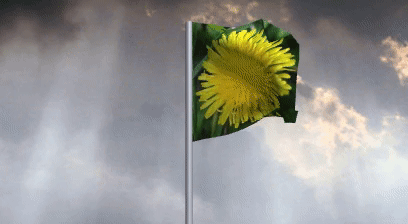
Great post, HH:)
I am very fortunate in the building where I live. There is a gardener and she plants us lots of edible herbs. My son has been snacking on the anise greens, just grabbing and branch and chomping down. He says it tastes just like candy. I agree it is rather tasty. I will be on a lookout for the poisonous hemlock. I will show him so he ever mistakes it for food. So important that we know the plants that can hurt us.
My dad always said, "If you can't have your own garden, cultivate a friendship with a gardener. " You've got a good deal with your own gardener! : ) And it's nice that your son is appreciating some fresh-grown herbs, especially some of the unusual ones, like anise. Folks that have access to community gardens really should be more aware of Poison Hemlock. There's really a 2-sided lesson. One side is that not everything growing in a garden is OK to eat, like rhubarb leaves or potato tops, or poison hemlock. The other side is that some weeds are as good to eat as anything people are trying to grow.
I only would harvest the ones I am certain of and I am realizing that I do not know how to identify hemlock. Hmmmm. I need to do more research.
You know some good weeds to eat, I think. I'm not much for hype -- to promote or to scare folks. But poison hemlock is one plant that every gardener should know. Lots of articles get carried away, saying don't put it in your compost pile, but their reason is concern that kids or animals might eat it. So I do compost it, when I see it. I don't have any neighbors trying to eat my compost, lol. It is a common weed. I wouldn't be surprised if you have it in your area. Once you start to notice it, you might see a lot of it!
I have wandered the woods with many knowledgeable plant experts and have never had anyone point it out to me. But I am reading that we do have it here. So many new invasive species!
I see new invasive plants every year. I think it comes from the landscaping and gardening industry, right over my neighbors' fences. The Nipplewort showed up about 3 years ago. It looked like it would take over everything, but it's calmed down. And it's good to eat. If only every invasive species was like that. If you do see the Poison Hemlock, I'd appreciate you letting me know! It will be in disturbed ground more than the woods. Your garlic mustard problem is enough for your poor woods!
My grandson is coming over this week to do a garlic mustard pulling session for me. I am doubtful it will fix the problem, but it may slow it down a bit! Poison ivy is a huge problem this year, too. I've got it coming up in the vinca by the front door!
Poison ivy is one of the real hazards of foraging! And going in and out of your front door, from the sounds of it, lol. Here in Oregon, it's Poison Oak -- and a big problem, too. Some places are impenetrable, and when there's a wildfire, the smoke carries the oil. Firefighters face a lot of risks.
It's nice to hear your grandson is willing and able to help out like that. Invasives mean we have to be diligent, every year, forever. It's almost overwhelming to think about. But your woods are so valuable, from what you've shown about them. Have fun with your grandson -- after the garlic mustard pulling! : )
The roadside is thick with it this year, so it's only a matter of time. I did read that garlic mustard can only sustain itself for 20-30 years, so maybe someday the native plants can recover.
Wild parsnip is a huge problem. It appears that nothing else is growing in the highway roadsides. It has taken over areas where there used to be large populations of milkweed.
That's at least some positive news about the garlic mustard. Although 20-30 years is a long time for you and me, from a landscape perspective it's not so long.
Wow. I didn't realize how much of a problem that Wild Parsnip (Pastinaca sativa) is in your region. It looks like you are in the heart of the invasive problem. The more folks can get on top of the problem early, the easier everyone has it. Poor milkweed and Monarch butterflies. They just aren't getting a break at all, between invasives and changes in farming.
Your Wild Parsnip seems almost as bad as the Giant Hogweed (Heracleum mantegazzianum). Here in Oregon, if folks see that one, teams are sent out to get rid of it immediately. The blistering leaves scars for years. What a contrast to all the plants that are so useful! These 2 make Garlic Mustard seem downright pleasant!
Excellent post!
I can find sow thistle a couple weeks out of the year. Queens Anne's lace is the one we have that looks like hemlock, but I haven't seen hemlock around. I think it may be too dry at this location for hemlock to survive.
Common purslane doesn't make it but 'horse purslane' will. Plantain is another I see on occasion.
Happy harvesting.
The sowthistles are some of my favorites! I'll have to look for that horse purslane when I'm in the right habitat. I don't know that one - and doing some quick research, it looks like I should! :D Yes, the poison hemlock likes some moisture, although it tolerates 3 months with almost no rain every summer, here in Oregon's Willamette Valley. Happy foraging!
Dude these gifs in here :) I absolutely LOVE them and they enhance the post so much.
But you are not deliberating planting these weeds right? These are just the ones that end up in between, am I correct. I really need a garden back when I see this...
I didn't plant any of these weeds - ever. They just blew in on the breeze or from birds. There have got to be so many weed seeds in the soil, just waiting for their chance!
que maravillas todas estas información ,a mi me encanta el jardín con estas plantas tan utiles
Thanks, @gladysob. If all the weeds were edible and tasty like these, it would be wonderful, lol. At least a lot of them were good! Happy gardening!
I am all about the edible weeds. The earth has so many gifts for us that people have forgotten. Thanks for this awesome post!
You would like the dandelions here in western Oregon, @carolynstahl! They are huge and delicious for months, where they grow in the shade or tall grass. So many of these plants are not originally from here, but were brought over as food plants. Some are even better eating than garden-grown greens, but they just don't stand up to shipping or holding for the markets. Enjoy your greens! : )
Wow the gifs are really a nice touch and helped me understand what I was reading better. Interesting. I swear I have seen that Poison hemlock before! The leaves seem to resemble small wild carrots leaves.
Thanks for that feedback, @old-guy-photos. I'm never sure whether the extra bandwidth of the GIFs is worth it for folks. I bet you have seen that Poison Hemlock. I know it's all over southern Michigan! I had it in my own gardens there. It likes disturbed areas. It gets pretty big - I've seen it over 6 feet tall. There's no mistaking it for a carrot then. But when it's young, that's the biggest concern.
I am going to look around this week, what I can find. This is an incredible information my Dear. You put so much time and effort not only harvesting, but also recording it all for us. Great job as always 🍒 🍌🍑🌿🍍🍓🍇
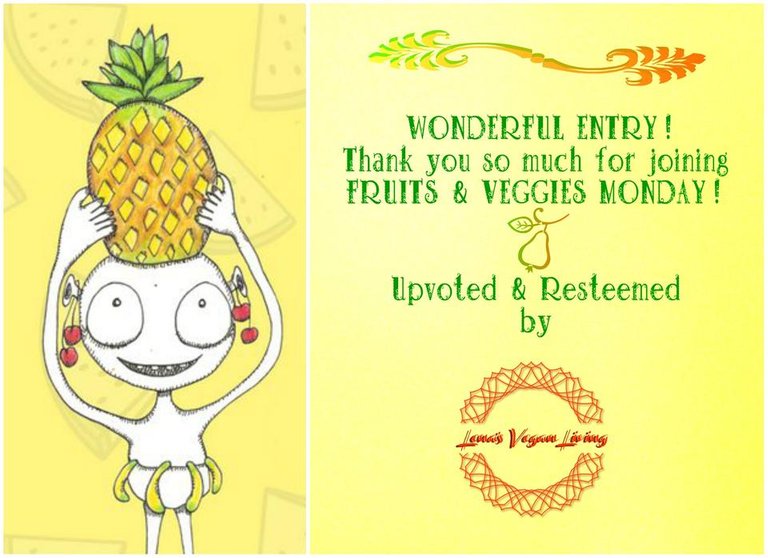
Thanks, @lenasveganliving! Eating well doesn't have to be expensive, with so many wonderful wild plants around us. Enjoy your fruits and veggies! :D
That is so true my Dear..............always a pleasure and thank you too 🌸💖🌸
CONGRATULATIONS! A WELL-EARNED AWARD!

I already said that, but I will repeat: it is not terrible to survive with you in the wild! :)
Thanks, @yetaras! There are so many plants worth eating, just growing wild out there. Every time I look, I am surprised at how many I see - and how much there is to harvest.
I remember growing up in an Italian family the old Italians would eat dandelion and some other wild plants that slips my memory now. I also remember my uncle taking me mushroom hunting. They would only go after one type of mushroom they knew very well that always grew on old oak tree stumps. They were usually very large. I'd be afraid to to take a chance on that since I can't remember what they looked like. All the old timers are gone now so I guess I'll never get those mushrooms again.
Crepis setosa are native to the Mediterranean region and still eaten there today, by the old-timers. So they may be the same as the ones you ate, too.I'm glad you got to experience that in your youth, @garden-to-eat. Some of these weeds that I eat, like the
I wonder what mushrooms your uncle was hunting! I eat a lot of different wild mushrooms. You can always learn the mushrooms yourself and then enjoy them. But you are smart to not try hunting them based on distant memories. In reading reports of mushrooms poisonings, that's a common situation. Someone remembers a mushroom from their youth, going out with older relatives, but they haven't foraged for it for years. The other common situation is folks that foraged a specific mushroom on one continent, like Europe, but then they move to another continent and find a mushroom that looks like one back home. But it is never too late to learn wild plants and mushrooms. They are out there -- waiting for you! :D
You give me always something new and very useful in your post! Extra practical fotos complement it :) Good for beginners,too!
Thanks, @liltammy. I"m glad you get something useful from my posts. There are so many wonderful plants to get to know! :D
I'm loving this new kind of gif posts!! They're cool and I get to see you working!
how better than the still photos. Got to keep shaking it up! ; )Thanks, @blacklux! I wonder whether it uses too much bandwidth for people on cellphones. The images are smaller, but I think they do show
I think its better this way. Its much easier to see how things are done and also its fun!! It would be cool if gifs had sound!
Maybe Steemit will expand to short video clips someday, like Instagram or Twitter. Don't hold your breath waiting, but we can dream, lol. And then the drones will show up to your beach bench with drinks and snacks, too. :D
Ooooooh! I like your thinking!!
Hi haphazard-hstead,
LEARN MORE: Join Curie on Discord chat and check the pinned notes (pushpin icon, upper right) for Curie Whitepaper, FAQ and most recent guidelines.
Thanks, @curie and curators! That was very unexpected!
@haphazard-hstead, for me gardening an activity that is certainly fun. Not only fun but gardening will also be more beneficial than filling your leisure time by not doing anything or just huddling with your neighbors. Another benefit is the availability of fresh vegetables every day, far from being fresher than the vegetables sold in the market.
I'm glad you enjoy gardening, @nurhayati! Enjoy all that beauty and good food, too!
@haphazard-hstead, enjoy living with pleasure, be yourself, may we continue to benefit all beings and plants.
I love this! When I was in Nicaragua I was helping my friend with a restaurant and the first thing we did was switch out many of his greens for native weeds. I now live in Bangkok and I see these boxes at the side of the road and when you go closer, you notice that people are growing all kinds of edible weeds in there that they sell in the shop right next to it; most notably I see butterfly pea everywhere. The problem is that I find that native people often don't know the word for them!
That's so cool about your Nicaraguan experience, @permieemmy! It must be so interesting to see so many wild plants in the Bangkok markets, too. I can relate to your challenge of finding out the name of the plants. My dad learned a lot of local wild plants from his grandmother -- none of the names match the accepted botanical names, lol. Thank goodness for ethnobotanists that can help us figure out what all those local plants are, in places all over the world. I"ve learned to enjoy eating some interesting things, based on their reports. I'll have to check out the Butterfly Pea and see if folks are growing it in gardens in my region. Enjoy your Bangkok plants! :D
Great tips with interesting information! I like the ways you harvested those weeds and explained how to use which parts of them clearly. You have good knowledge on foraging indeed.
As I told you before, I like the dandelion flowers, really beautiful…
Thanks so much for sharing. ;)
Thanks, @tangmo. I like how my selection of weeds changes through the year. Every weed and wild plant has its own season of when it's best for eating. So my harvest is always changing, especially as spring moves into summer. Dandelion flowers are good anytime they are around! They are a bright spot, for sure! Enjoy all the plants around you -- I know you appreciate the beauty of flowers!
You’re welcome! Yeah! That’s why I like to read your article about your selection of the weeds and the wild plants and the way you cooked them…. Really great!
I absolutely agree with you, “dandelion” is beautiful flower in bright color and it would be really wonderful if they are around. And I like your profile picture with this flower very much.
Many thanks again for always knowing me well! Yeah! I enjoy all plants around me and appreciate the beauty of flowers….and I also love to see all plants around you through your posts…. Looking forward to seeing more photos and learning more information of them! ;)
Wow, you are a real expert. I'm sure that you'll never go hungry! I didn't know about the danger of poisonous weeds!
Daucus carota) even when they are right next to Poison Hemlock. But if this was the Giant Hogweed (Heracleum mantegazzianum), I'd stay away!What a surprise to see you in these parts again, @kus-knee! Some weeds are even worse than Poison Hemlock! I harvest wild carrots (
Where I live almost everything is an edible or a medicinal and there are no true poisonous plants. Poison ivy is rare in south east New Brunswick. Once they are in your garden even the most beneficial native plant can become a pesky weed. I used buckwheat as a cover crop one year, its a nitrogen fixing plant, and a weed. It crowds out other weeds and their seeds and is easy to remove, so it's got it's advantages weed wise. I also run a homesteading and gardening blog, please check it out; https://steemit.com/blog/@mobios/daddy-why-won-t-spring-come
nawara de fino. cuando yo limpio mi patio todo eso va para afuera. ahora ya se que se puede comer. voy a intentar para ver a que sabe.
It´s a job amazing!
As always an informative post out of the top drawer.